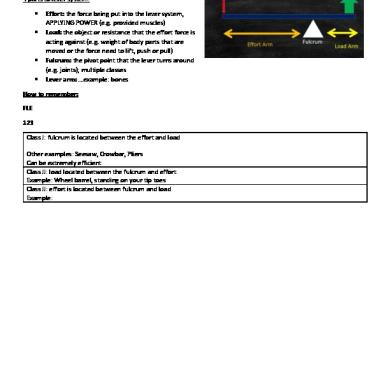426-46 Lever Systems
This document was uploaded by user and they confirmed that they have the permission to share it. If you are author or own the copyright of this book, please report to us by using this DMCA report form. Report DMCA
Overview
Download & View 426-46 Lever Systems as PDF for free.
More details
- Words: 863
- Pages: 23
Lever Systems • Classified systems of torque • Relative positions of force, resistance, and axis of rotation vary in the different types or classes of levers • As with any torque calculations, operations on levers determine the tendency for some force to produce rotation around a fixed point.
Components of a Lever System • Fulcrum – The center or axis of rotation of the system. • Moment Arm – The distance from any force or weight that produces torque to the fulcrum. • Force Arm – The distance from an applied force to the fulcrum. (The moment arm of the force.) • Resistance Arm – The distance from the resistance to the fulcrum. (The moment arm of the resistance.)
Classes of Levers 1. First Class – The applied force and the resistance are on opposite sides of the fulcrum. 2. Second Class – The resistance is between the applied force and the fulcrum. 3. Third Class – The applied force is between the resistance and the fulcrum.
First Class Lever resistance
applied force force arm
resistance arm
fulcrum
Second Class Lever force arm resistance arm
fulcrum
resistance
applied force
Third Class Lever resistance arm force arm
fulcrum
resistance applied force
Torque Produced in Lever Systems •
Two Torques 1. Torque produced by the applied force 2. Torque produced by the resistance
•
The direction in which a lever system moves is dependent on the relative lengths of the force and resistance arms as well as the magnitudes of force and resistance.
Mechanical Advantage This is the effectiveness of a lever at moving a resistance. It is a calculated value: ForceArm Mechanical = Advantage Re sis tan ceArm
Because of their different configurations, the mechanical advantage of a first class lever can favor the force or resistance depending on the placement of the fulcrum. A second class lever always favors the force arm. A third class lever always favors the resistance arm.
resistance
applied force force arm
resistance arm
fulcrum The fulcrum in a first class lever system can often vary in position to favor the force arm or the resistance arm.
force arm resistance arm
resistance
applied force
fulcrum In a second class lever system, the mechanical advantage favors the force arm. (The force arm will always be longer.)
resistance arm force arm
resistance applied force
fulcrum The mechanical advantage of a third class lever system favors the resistance arm. (The resistance arm is always longer.)
Resistance and Force Arms • Resistance Arm: Abbreviated DRA • Force Arm: Abbreviated DFA
Levers In The Musculo-Skeletal System • Most are third class levers • This system produces a disadvantage for force but an advantage for speed of movement
Levers In The Musculo-Skeletal System Most of the musculo-skeletal system consists of third class levers. That is, the resistance arm is longer than the force arm. FM
FRO
DFA DRA
R
Levers In The Musculo-Skeletal System
B
A
The musculo-skeletal lever systems generally favor speed over strength. Although the mechanical advantage favors the resistance arm, in the time that the muscle insertion moves a given distance (red arrow), the resistance moves a much greater distance (blue arrow).
Levers In The Musculo-Skeletal System
B
A
In other words, the end of a limb is moving at a greater velocity than the attachments of the muscles that produce that movement.
Strength vs. Speed in Skeletal Muscle • mechanical advantage = (DFA)/(DRA) If DFA < DRA the mechanical advantage is < 1 Example: A muscle inserts 3 cm from a joint axis (DFA = 3 cm) The distance to the weight that the muscle is resisting is 30 cm (DRA = 30 cm) mechanical advantage = 3 cm / 30 cm = .1 This means that, when FM and R are both perpendicular to the limb, FM must be 10 times greater than R to move the resistance.
Strength vs. Speed in Skeletal Muscle
θ
• In a muscle contraction on a limb like the arm or leg, the resistance moves through the same angular displacement as the muscle insertion.
Strength vs. Speed in Skeletal Muscle
θ
• In moving through a given angular displacement (θ), the velocity of the resistance is equal to the angular velocity in rad/sec times DRA • The velocity of the muscle insertion is equal to the angular velocity in rad/sec times DFA
Strength vs. Speed in Skeletal Muscle
FM
FRO
DFA DRA
R
Strength vs. Speed in Skeletal Muscle • The velocity of the resistance: vR = (ω rad/sec)(DRA) • The velocity of the muscle insertion: vM = (ω rad/sec)(DFA) • The velocity of the resistance compared to the muscle insertion = vR/vM = (ω rad/sec)(DRA)/ (ω rad/sec)(DFA) = DRA/DFA
Strength vs. Speed in Skeletal Muscle • If DFA = 3 cm and DRA = 30 cm, The relative speed of the resistance to the muscle insertion = DRA/DFA = (30 cm)/(3 cm) = 10 This means that the resistance is moving at 10 times the velocity of the muscle insertion.
Levers in the Musculo-Skeletal System
R DRA
fulcrum
DFA
FM
• Not all levers in the musculo-skeletal system are third class. When performing toe rises the ankle becomes a second class lever system.
Components of a Lever System • Fulcrum – The center or axis of rotation of the system. • Moment Arm – The distance from any force or weight that produces torque to the fulcrum. • Force Arm – The distance from an applied force to the fulcrum. (The moment arm of the force.) • Resistance Arm – The distance from the resistance to the fulcrum. (The moment arm of the resistance.)
Classes of Levers 1. First Class – The applied force and the resistance are on opposite sides of the fulcrum. 2. Second Class – The resistance is between the applied force and the fulcrum. 3. Third Class – The applied force is between the resistance and the fulcrum.
First Class Lever resistance
applied force force arm
resistance arm
fulcrum
Second Class Lever force arm resistance arm
fulcrum
resistance
applied force
Third Class Lever resistance arm force arm
fulcrum
resistance applied force
Torque Produced in Lever Systems •
Two Torques 1. Torque produced by the applied force 2. Torque produced by the resistance
•
The direction in which a lever system moves is dependent on the relative lengths of the force and resistance arms as well as the magnitudes of force and resistance.
Mechanical Advantage This is the effectiveness of a lever at moving a resistance. It is a calculated value: ForceArm Mechanical = Advantage Re sis tan ceArm
Because of their different configurations, the mechanical advantage of a first class lever can favor the force or resistance depending on the placement of the fulcrum. A second class lever always favors the force arm. A third class lever always favors the resistance arm.
resistance
applied force force arm
resistance arm
fulcrum The fulcrum in a first class lever system can often vary in position to favor the force arm or the resistance arm.
force arm resistance arm
resistance
applied force
fulcrum In a second class lever system, the mechanical advantage favors the force arm. (The force arm will always be longer.)
resistance arm force arm
resistance applied force
fulcrum The mechanical advantage of a third class lever system favors the resistance arm. (The resistance arm is always longer.)
Resistance and Force Arms • Resistance Arm: Abbreviated DRA • Force Arm: Abbreviated DFA
Levers In The Musculo-Skeletal System • Most are third class levers • This system produces a disadvantage for force but an advantage for speed of movement
Levers In The Musculo-Skeletal System Most of the musculo-skeletal system consists of third class levers. That is, the resistance arm is longer than the force arm. FM
FRO
DFA DRA
R
Levers In The Musculo-Skeletal System
B
A
The musculo-skeletal lever systems generally favor speed over strength. Although the mechanical advantage favors the resistance arm, in the time that the muscle insertion moves a given distance (red arrow), the resistance moves a much greater distance (blue arrow).
Levers In The Musculo-Skeletal System
B
A
In other words, the end of a limb is moving at a greater velocity than the attachments of the muscles that produce that movement.
Strength vs. Speed in Skeletal Muscle • mechanical advantage = (DFA)/(DRA) If DFA < DRA the mechanical advantage is < 1 Example: A muscle inserts 3 cm from a joint axis (DFA = 3 cm) The distance to the weight that the muscle is resisting is 30 cm (DRA = 30 cm) mechanical advantage = 3 cm / 30 cm = .1 This means that, when FM and R are both perpendicular to the limb, FM must be 10 times greater than R to move the resistance.
Strength vs. Speed in Skeletal Muscle
θ
• In a muscle contraction on a limb like the arm or leg, the resistance moves through the same angular displacement as the muscle insertion.
Strength vs. Speed in Skeletal Muscle
θ
• In moving through a given angular displacement (θ), the velocity of the resistance is equal to the angular velocity in rad/sec times DRA • The velocity of the muscle insertion is equal to the angular velocity in rad/sec times DFA
Strength vs. Speed in Skeletal Muscle
FM
FRO
DFA DRA
R
Strength vs. Speed in Skeletal Muscle • The velocity of the resistance: vR = (ω rad/sec)(DRA) • The velocity of the muscle insertion: vM = (ω rad/sec)(DFA) • The velocity of the resistance compared to the muscle insertion = vR/vM = (ω rad/sec)(DRA)/ (ω rad/sec)(DFA) = DRA/DFA
Strength vs. Speed in Skeletal Muscle • If DFA = 3 cm and DRA = 30 cm, The relative speed of the resistance to the muscle insertion = DRA/DFA = (30 cm)/(3 cm) = 10 This means that the resistance is moving at 10 times the velocity of the muscle insertion.
Levers in the Musculo-Skeletal System
R DRA
fulcrum
DFA
FM
• Not all levers in the musculo-skeletal system are third class. When performing toe rises the ankle becomes a second class lever system.
Related Documents

426-46 Lever Systems
June 2020 7
Lever Be
December 2019 28
Lever Watches.docx
April 2020 20
Hindustan Lever
October 2019 27
Lever System.docx
May 2020 14
Lever Ghanauli
November 2019 16More Documents from ""

Galvanic Corrosion Presentation
June 2020 9
Product Design
June 2020 18
426-46 Lever Systems
June 2020 7
Introduction To Design Synectics-student Version
June 2020 6
Life Cycle Costing And Reliability Engg
June 2020 6